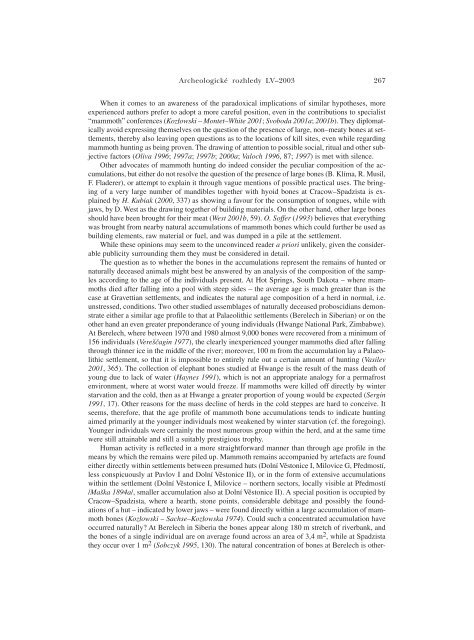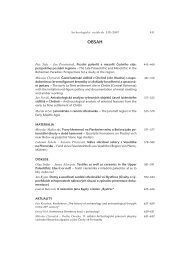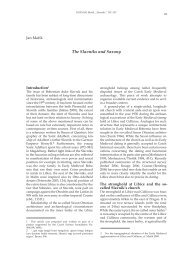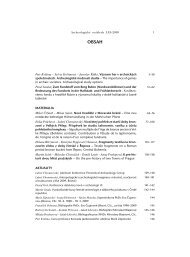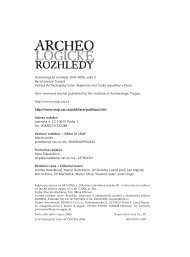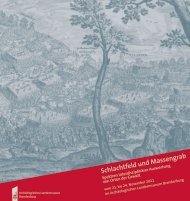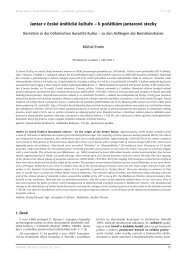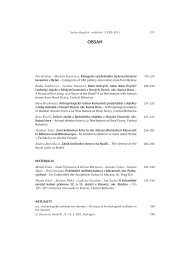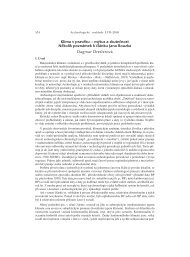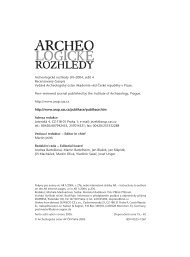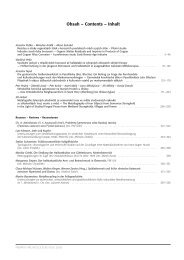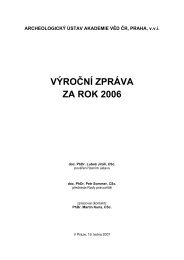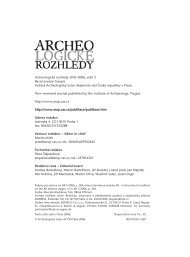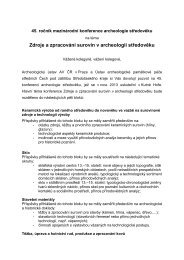2003_2 - Archeologický ústav AV ČR
2003_2 - Archeologický ústav AV ČR
2003_2 - Archeologický ústav AV ČR
Create successful ePaper yourself
Turn your PDF publications into a flip-book with our unique Google optimized e-Paper software.
Archeologické rozhledy LV–<strong>2003</strong> 267When it comes to an awareness of the paradoxical implications of similar hypotheses, moreexperienced authors prefer to adopt a more careful position, even in the contributions to specialist“mammoth” conferences (Kozłowski – Montet–White 2001; Svoboda 2001a; 2001b). They diplomaticallyavoid expressing themselves on the question of the presence of large, non–meaty bones at settlements,thereby also leaving open questions as to the locations of kill sites, even while regardingmammoth hunting as being proven. The drawing of attention to possible social, ritual and other subjectivefactors (Oliva 1996; 1997a; 1997b; 2000a; Valoch 1996, 87; 1997) is met with silence.Other advocates of mammoth hunting do indeed consider the peculiar composition of the accumulations,but either do not resolve the question of the presence of large bones (B. Klíma, R. Musil,F. Fladerer), or attempt to explain it through vague mentions of possible practical uses. The bringingof a very large number of mandibles together with hyoid bones at Cracow–Spadzista is explainedby H. Kubiak (2000, 337) as showing a favour for the consumption of tongues, while withjaws, by D. West as the drawing together of building materials. On the other hand, other large bonesshould have been brought for their meat (West 2001b, 59). O. Soffer (1993) believes that everythingwas brought from nearby natural accumulations of mammoth bones which could further be used asbuilding elements, raw material or fuel, and was dumped in a pile at the settlement.While these opinions may seem to the unconvinced reader a priori unlikely, given the considerablepublicity surrounding them they must be considered in detail.The question as to whether the bones in the accumulations represent the remains of hunted ornaturally deceased animals might best be answered by an analysis of the composition of the samplesaccording to the age of the individuals present. At Hot Springs, South Dakota – where mammothsdied after falling into a pool with steep sides – the average age is much greater than is thecase at Gravettian settlements, and indicates the natural age composition of a herd in normal, i.e.unstressed, conditions. Two other studied assemblages of naturally deceased proboscidians demonstrateeither a similar age profile to that at Palaeolithic settlements (Berelech in Siberian) or on theother hand an even greater preponderance of young individuals (Hwange National Park, Zimbabwe).At Berelech, where between 1970 and 1980 almost 9,000 bones were recovered from a minimum of156 individuals (Vereščagin 1977), the clearly inexperienced younger mammoths died after fallingthrough thinner ice in the middle of the river; moreover, 100 m from the accumulation lay a Palaeolithicsettlement, so that it is impossible to entirely rule out a certain amount of hunting (Vasilev2001, 365). The collection of elephant bones studied at Hwange is the result of the mass death ofyoung due to lack of water (Haynes 1991), which is not an appropriate analogy for a permafrostenvironment, where at worst water would freeze. If mammoths were killed off directly by winterstarvation and the cold, then as at Hwange a greater proportion of young would be expected (Sergin1991, 17). Other reasons for the mass decline of herds in the cold steppes are hard to conceive. Itseems, therefore, that the age profile of mammoth bone accumulations tends to indicate huntingaimed primarily at the younger individuals most weakened by winter starvation (cf. the foregoing).Younger individuals were certainly the most numerous group within the herd, and at the same timewere still attainable and still a suitably prestigious trophy.Human activity is reflected in a more straightforward manner than through age profile in themeans by which the remains were piled up. Mammoth remains accompanied by artefacts are foundeither directly within settlements between presumed huts (Dolní Věstonice I, Milovice G, Předmostí,less conspicuously at Pavlov I and Dolní Věstonice II), or in the form of extensive accumulationswithin the settlement (Dolní Věstonice I, Milovice – northern sectors, locally visible at Předmostí/Maška 1894a/, smaller accumulation also at Dolní Věstonice II). A special position is occupied byCracow–Spadzista, where a hearth, stone points, considerable debitage and possibly the foundationsof a hut – indicated by lower jaws – were found directly within a large accumulation of mammothbones (Kozłowski – Sachse–Kozłowska 1974). Could such a concentrated accumulation haveoccurred naturally? At Berelech in Siberia the bones appear along 180 m stretch of riverbank, andthe bones of a single individual are on average found across an area of 3,4 m 2 , while at Spadzistathey occur over 1 m 2 (Sobczyk 1995, 130). The natural concentration of bones at Berelech is other-


